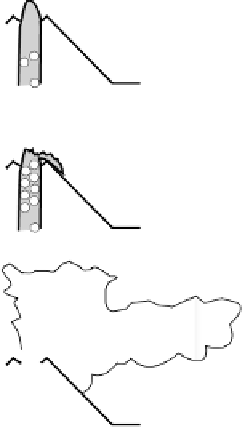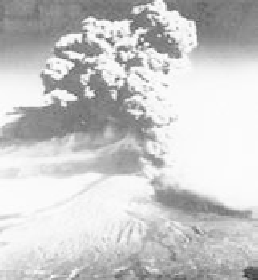Geoscience Reference
In-Depth Information
Dacite dome grows;
tropical storms cause
fragmentation
UMBRELLA
Dome collapse; initial
eruption column;
column margin
downflow and
pyroclastic flows
CONVECTIVE
THRUST
GAS THRUST
Fragmentatio
n
VESICULATION
Exsolution
Main eruption column
and cloud
Fig. 5.33
Schematic of lava dome growth, collapse, and eruption
sequence, based on Montserrate volcano.
Fig. 5.31
The sequence of events thought to occur in the magma
chamber and in the overlying eruption column of a Plinean
eruption.
define part of a broad spectrum of
pyroclastic density currents
(see further below).
It is necessary to consider the processes acting in
Vulcanian/Plinian eruptions a little more carefully
(Fig. 5.31), both on account of associated extreme hazards
and for the sake of the physical exploration of the difficul-
ties and challenges of understanding one of Earth's three-
phase (solid-melt-gas) systems. Consider the general
situation of an intermediate composition magma stream
rising through an open volcanic conduit. Internal lithosta-
tic pressure is continuously being reduced, which lowers
volatile (chiefly water) solubility to saturation level and
then permits release from solution. When this
decompres-
sion
causes local internal pressure to lower below the level
of vapor pressure appropriate to the temperature involved,
the disseminated volatile molecules nucleate, form discrete
bubbles, and initiate melt boiling. The bubbles continue
to grow by diffusion from the boiling melt, further enlarg-
ing as they rise until their internal fluid pressure equals that
of the vapor phase pressure in the surrounding melt.
Calculated times for bubble growth range between
16 and 70 min for major eruptions. This
first boiling phase
begins at 2-5 km depths for andesitic magma water satu-
ration of 3-5 wt%. A second boiling phase may occur as
crystallization reaches a maximum, latent heat of crystal-
lization is released, and any remaining melt volatiles exsolve
and nucleate. Eventually the rising, frothy magma reaches
(a)
(b)
Fig. 5.32
Infamous explosive volcanoes in action. (a) Mt St Helens
(Plinean phase) 1980 and (b) Vesuvius erupting 1944.


















































Search WWH ::

Custom Search